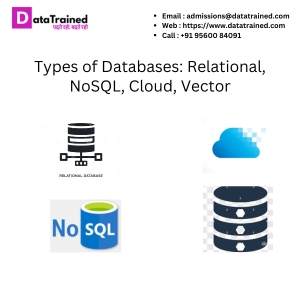Types of Databases: Relational, NoSQL, Cloud, VectorPosted by Data Trained on June 20th, 2024  Databases are the backbone of storing and managing vast amounts of information efficiently. Understanding the different types of databases is crucial for businesses and developers to make informed decisions about data storage and retrieval strategies. What is a Database?A database is a structured collection of data that allows for efficient storage, retrieval, and management of information. It acts as a digital filing system, organizing data into tables, rows, and columns for easy access and manipulation. Also read: Enroll in Data Science Course with Placement Guarantee. Importance of Choosing the Right Database TypeChoosing the appropriate database type is vital as it impacts application performance, scalability, and data integrity. Different types of databases offer varying features suited to different use cases. Relational DatabasesRelational databases store data in structured tables with predefined schemas. Each table consists of rows (records) and columns (fields), with relationships defined between tables. Popular ExamplesSome well-known relational database management systems (RDBMS) include MySQL, PostgreSQL, Oracle, and SQL Server. These systems are widely used for their robustness in handling structured data. Advantages of Relational DatabasesRelational databases ensure data integrity through ACID (Atomicity, Consistency, Isolation, Durability) transactions. They support complex queries and are suitable for applications requiring structured data management. Also read: Get started with Data Science Classes near you. Limitations and Use CasesWhile effective for structured data, relational databases may face challenges with scalability and flexibility in handling unstructured or semi-structured data types like documents or JSON. NoSQL DatabasesNoSQL databases diverge from relational models by offering schema flexibility and horizontal scalability. They are designed to handle large volumes of unstructured data efficiently. Types of NoSQL DatabasesMajor categories include: Document stores: Storing data in flexible, JSON-like documents (e.g., MongoDB). Use CasesNoSQL databases excel in scenarios requiring flexible data models, such as real-time web applications, content management systems, and IoT (Internet of Things) platforms. ChallengesDespite their advantages, NoSQL databases can introduce complexity in data consistency and querying due to eventual consistency models and lack of standardized query languages. Cloud DatabasesCloud databases are hosted on cloud computing platforms, offering scalability, accessibility, and cost-efficiency compared to traditional on-premises solutions. Also read: Start your Data Scientist Classes to enhance your skill-sets. Leading ProvidersMajor cloud database providers include: Amazon Web Services (AWS): Offering Amazon RDS (Relational Database Service) and Amazon DynamoDB. BenefitsCloud databases offer benefits such as automated backups, global availability, and flexible pricing models based on usage (pay-as-you-go). They eliminate the need for on-premises hardware maintenance and provide robust security measures. ConsiderationsFactors like data security, compliance requirements, and vendor lock-in risks should be evaluated before migrating to a cloud database solution. Organizations must choose providers that align with their specific needs and regulatory standards. Also read: Learn the Data Science Full Course from DataTrained Today! Vector DatabasesVector databases specialize in storing and querying high-dimensional vector data used extensively in machine learning, AI, and scientific applications. ApplicationsThey find applications in: Recommendation systems: Storing user preferences and item features. AdvantagesVector databases optimize storage and retrieval of high-dimensional data, supporting efficient similarity search operations crucial for AI-driven applications. LimitationsHowever, they may be less suitable for general-purpose transactional data management and may require specialized knowledge for optimal performance tuning. Also read: Get your IBM Certified Data Science Degree along with Certificate Today! In conclusion, the diversity of database types provides organizations with a range of options to meet specific data management needs. Relational databases excel in maintaining data integrity and supporting complex queries, while NoSQL databases offer flexibility and scalability for unstructured data. Cloud databases enhance accessibility and scalability, and vector databases cater specifically to high-dimensional data requirements in AI and machine learning. Choosing the right database type involves evaluating the application's needs, scalability requirements, and data complexity to ensure optimal performance and efficiency. Like it? Share it!More by this author |


